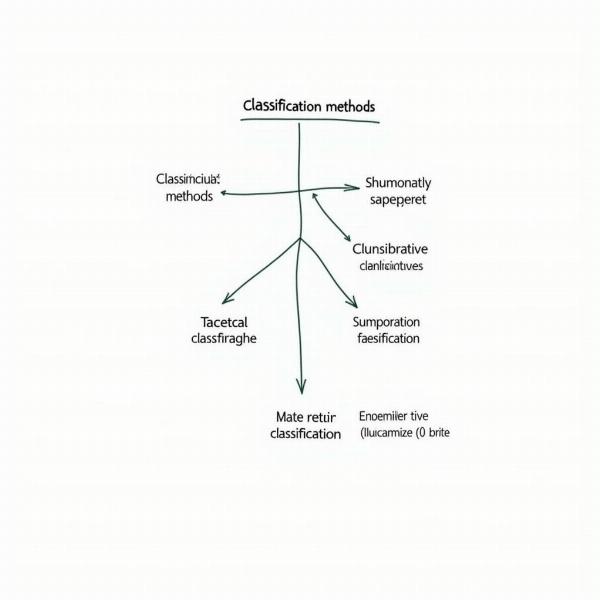Classification, a fundamental concept across various disciplines, finds its Hindi equivalent as “वर्गीकरण” (vargīkaraṇ). Understanding its meaning and application is crucial for effective communication and comprehension in Hindi. Whether you’re delving into scientific literature, navigating business documents, or simply engaging in everyday conversations, grasping the nuances of “classification” in Hindi will significantly enhance your understanding.
Understanding “Vargīkaraṇ” (Classification)
The Hindi word “वर्गीकरण” (vargīkaraṇ) stems from “वर्ग” (varg), meaning “class” or “group.” Therefore, “vargīkaraṇ” signifies the process of organizing or categorizing items, concepts, or entities into distinct groups based on shared characteristics, properties, or criteria. This systematic arrangement facilitates easier analysis, comparison, and understanding of the classified elements. Imagine sorting a basket of mixed fruits – apples, oranges, and bananas. This simple act of separating them into groups exemplifies the essence of “vargīkaraṇ.”
Classification in Scientific Contexts
In scientific fields like biology, “vargīkaraṇ” plays a vital role in taxonomy – the science of classifying organisms. From the broadest kingdom to the most specific species, “vargīkaraṇ” provides a structured framework for understanding the relationships between different life forms. Similarly, in chemistry, elements are classified based on their atomic structure and properties, enabling scientists to predict their behavior and interactions.
Classification in Business and Commerce
Within the business world, “classification” in Hindi (vargīkaraṇ) helps streamline operations and manage data effectively. Products, customers, and financial transactions are often classified for analysis, reporting, and decision-making. For example, category rank meaning in hindi is relevant in understanding product hierarchies. This structured approach enables businesses to target specific customer segments, optimize inventory management, and enhance overall efficiency.
Different Methods of Classification
“Vargīkaraṇ” can be implemented through various methods, each tailored to specific needs and contexts. Hierarchical classification, for example, arranges items in a tree-like structure, with broader categories branching into more specific subcategories. This method is commonly used in library systems and biological taxonomy. Other methods include facet classification, which categorizes items based on multiple attributes, and enumerative classification, which assigns a unique code to each item within a predefined list. Understanding these diverse methods is crucial for effectively utilizing “vargīkaraṇ” in various situations.
 Different Classification Methods in Hindi
Different Classification Methods in Hindi
How is “Classification” Used in Daily Life?
Even in our everyday lives, we subconsciously employ “vargīkaraṇ.” Organizing our clothes by color, arranging books by genre, or sorting emails into folders are all examples of practical applications of “classification.” These simple acts of categorization bring order and efficiency to our daily routines. Understanding the significance of xerus meaning in hindi or makruh meaning in hindi can be considered a specific type of classification within the realm of language.
Conclusion
“Classification in Hindi meaning” – “वर्गीकरण” (vargīkaraṇ) – is a fundamental concept with far-reaching implications. From scientific research to everyday organization, its principles enable us to understand and navigate the world around us. By grasping the meaning and various applications of “vargīkaraṇ,” you can enhance your communication skills, improve your understanding of diverse subjects, and bring greater efficiency to your personal and professional endeavors.
FAQ
-
What is the most common synonym for “vargīkaraṇ” in Hindi? While “वर्गीकरण” is the most widely used term, “श्रेणीकरण” (śreṇīkaraṇ), meaning “categorization,” is a close synonym.
-
How does “vargīkaraṇ” differ from “विभाजन” (vibhājan – division)? While both involve separating things, “vargīkaraṇ” emphasizes grouping based on shared characteristics, whereas “vibhājan” focuses on the act of separating or dividing without necessarily implying grouping based on similar traits.
-
Is “vargīkaraṇ” used in legal contexts? Yes, legal documents often use “vargīkaraṇ” to categorize different types of offenses, legal procedures, and evidence.
-
What are some examples of “vargīkaraṇ” in education? Students are often classified by grade level, academic performance, and learning styles. Educational materials are also categorized by subject, topic, and difficulty level.
-
How does understanding “vargīkaraṇ” benefit language learning? Classifying vocabulary by parts of speech, themes, or usage patterns can significantly enhance vocabulary acquisition and language comprehension.
Meaning-Hindi.in is your trusted partner for professional Hindi translation services. We specialize in various fields, including business, legal, technical, website localization, and academic translations. Our team of expert linguists ensures accurate and culturally sensitive translations, tailored to your specific needs. Whether you require butter beans hindi name or coking meaning in hindi, our expertise covers a wide range of specialized terminology. Contact us today for a free quote at [email protected] or call us at +91 11-4502-7584. Meaning-Hindi.in is committed to delivering high-quality language solutions that bridge communication gaps and empower global connections.